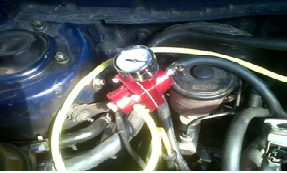Main Article Content
Abstract
Masalah klasik pada mesin-mesin EFI lama adalah emisi CO dan HC yang cenderung tinggi. Sementara, jika pembakaran diatur dalam campuran miskin (lean mixture), torsi mesin terbaik tidak diperoleh. Untuk itu, artikel ini menyajikan studi eksperimen tentang variasi tekanan bahan bakar dalam fuel rail. Untuk mengatur tekanan, sebuah adjustable pressure regulator diterapkan untuk membuat tekanan awal 1,8 sampai 2,6 Kg/cm² dengan interval 0,2. Hasilnya, emisi CO dan HC meningkat sesuai dengan peningakatan tekanan bahan bakar. Namun demikian, aplikasi adjustable pressure regulator pada mesin Efi memberikan solusi untuk melakukan pengaturan performa dan emisi dengan cara yang sederhana.
Keywords
Mesin EFI
Pressure regulator
Tekanan bahan bakar
Emisi
Article Details
References
-
[1] A. Jamrozik and W. Tutak, “A study of performance and emissions of SI engine with a two-stage combustion system,” Chemical and Process Engineering - Inzynieria Chemiczna i Procesowa, vol. 32, no. 4, pp. 453–471, 2011.
[2] A. K. Agarwal, D. K. Srivastava, A. Dhar, R. K. Maurya, P. C. Shukla, and A. P. Singh, “Effect of fuel injection timing and pressure on combustion, emissions and performance characteristics of a single cylinder diesel engine,” Fuel, vol. 111, no. January 2014, pp. 374–383, 2013.
[3] S. Sobhani, Air Pollution from Gasoline Powered Vehicles and the Potential Benefits of Ethanol Blending, no. October. United Nations Foundation, 2016.
[4] R. . Colvile, E. . Hutchinson, J. . Mindell, and R. . Warren, “The transport sector as a source of air pollution,” Atmospheric Environment, vol. 35, no. 9, pp. 1537–1565, Mar. 2001.
[5] S. Widodo, “Kajian Perbedaan Kualitas Emisi Gas Buang Mobil Bensin yang Menggunakan Sistem Pembakaran Electronic Fuel Injection (Efi) dan yang Menggunakan Sistem Pembakaran Karburasi,” Universitas Diponegoro, 2016.
[6] W. J. Martin, “Using KELEA (Kinetic Energy Limiting Electrostatic Attraction) to Improve the Efficiency of Fuel Combustion,” Open Journal of Air Pollution, vol. 06, no. 03, pp. 103–116, 2017.
[7] E. Amaechi and O. J. Boro, “Effect of Heat Expansion in an Internal Combustion Automotive Engine,” The International Journal Of Engineering And Science (IJES), vol. 5, no. 1, pp. 30–35, 2016.
[8] A. Sonthalia, C. Rameshkumar, U. Sharma, A. Punganur, and S. Abbas, “Combustion and performance characteristics of a small spark ignition engine fuelled with HCNG,” Journal of Engineering Science and Technology, vol. 10, no. 4, pp. 404–419, 2015.
[9] G. Satheeshkumar, “Analysis of Combustion and Emission Characteristics of SI Engine Powered with Diethyl Ether Blended Petrol as Fuel,” Global Research and Development Journal for Engineering, no. July, pp. 48–53, 2016.
[10] B. Waluyo, I. N. G. Wardana, L. Yuliati, and M. N. Sasongko, “The role of molecule cluster on the azeotrope and boiling points of isooctane-ethanol blend,” Fuel, vol. 215, no. September 2017, pp. 178–186, 2018.
[11] M. Setiyo, B. Waluyo, M. Husni, and D. W. Karmiadji, “Characteristics of 1500 CC LPG fueled engine at various of mixer venturi area applied on Tesla A-100 LPG vaporizer,” Jurnal Teknologi, 2016.
[12] M. Setiyo and S. Munahar, “AFR and fuel cut-off modeling of LPG-fueled engine based on engine, transmission, and brake system using fuzzy logic controller (FLC),” Journal of Mechatronics, Electrical Power, and Vehicular Technology, vol. 8, pp. 50–59, 2017.
[13] S. Munahar and M. Setiyo, “AFR Modeling of EFI Engine Based on Engine Dynamics, Vehicle Dynamics, and Transmission System,” Jurnal Teknik Mesin, vol. 7, no. 1, pp. 21–29, 2017.
[14] B. C. Purnomo, W. Widodo, S. Munahar, M. Setiyo, and B. Waluyo, “Karakteristik Emisi Gas Buang Kendaraan Berbahan Bakar LPG untuk Mesin Bensin Singke Piston,” in The 6th URECOL, 2017, pp. 7–12.

